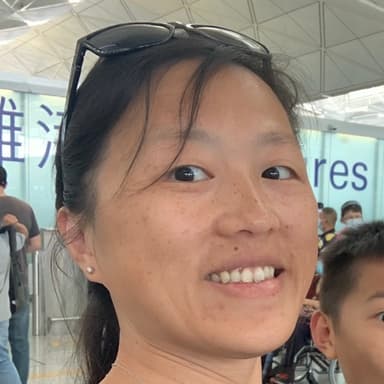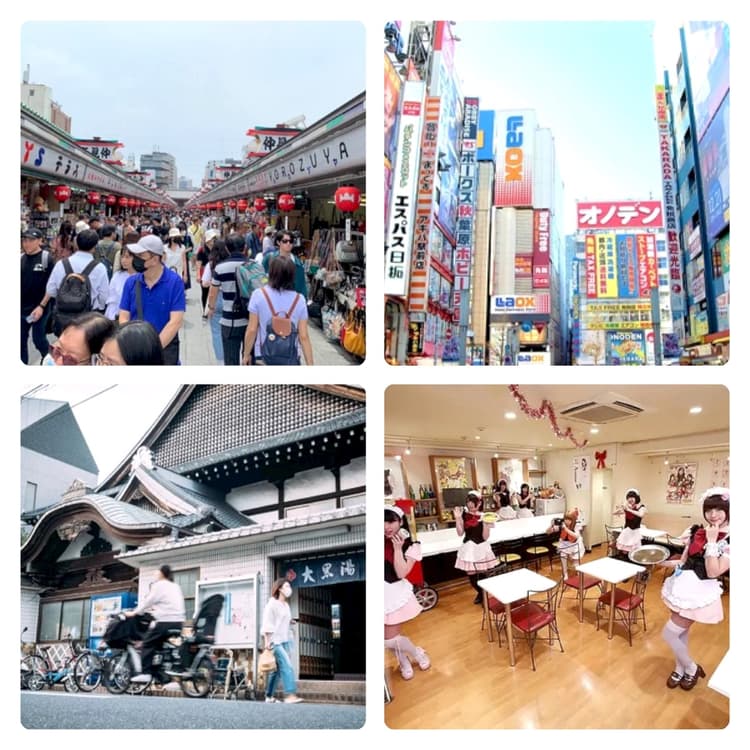Our Walking Tour in Lisbon, Portugal
Posted by Grace on July 19, 2024
Our family’s favorite thing (accurately speaking, both my husband and I) to do is take a walking tour when visiting a new city or country. This helps us understand the history and culture from a local’s perspective. We are often seen as the only group in the tour with kids, haha.
(My kids, like many, are not yet at the age that they are interested in history, but they have to go with us.)
Here is a snapshot of our wonderful walking tour in Lisbon in July 2024. I learned so much and I wish I could record more of my learnings, but my words are so limited.
Contents
- The Look of the City
- Food and Drinks
- Stories behind the Historical Sites
- Language
- A Chat with A Local Chinese Restaurant
- Conclusion
The Look of the City
One of the first things that struck me about Lisbon was the relative calm during rush hours. Unlike many bustling cities, the streets and subways of Lisbon seemed quieter, offering a more relaxed pace of life.
Lisbon is very hilly, which offers stunning viewpoints at every turn. However, it would be definitely challenging for people who are not used to the hilly walk. We accidentally discovered that the funiculars (like the Funicular da Graça) in Lisbon offer free rides to the top of the city's many hills, where you can take great city shots. Definitely, have very comfortable ergonomic walking shoes to protect your knees.

The buildings are close to each other, providing much-needed shade, especially in the hot summer of Lisbon.
The city surprisingly has many old buildings that look underdeveloped. It was told that many investors bought buildings in this historical city, but the city refused to give out permissions for the investors to renovate. Ongoing legal battles leave these torn buildings in limbo.
Food and Drinks
As I wandered through the city, I noticed the delicious aroma of egg tarts wafting from bakeries. These famous Portuguese pastries are notably sweeter than their Hong Kong counterparts. I heard that a cup of coffee and an egg tart is the default for locals to sit down and meet.
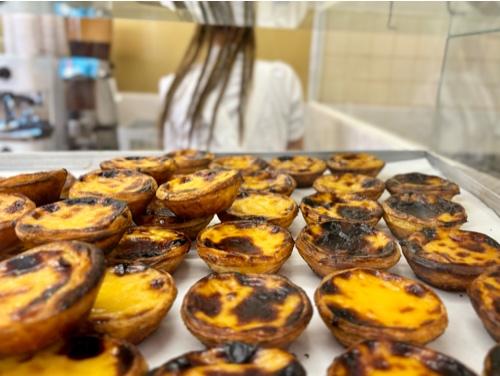
Our tour guide introduced us to "ginjinha," a little cherry liquor that costs just $1.55—a must-try for visitors.
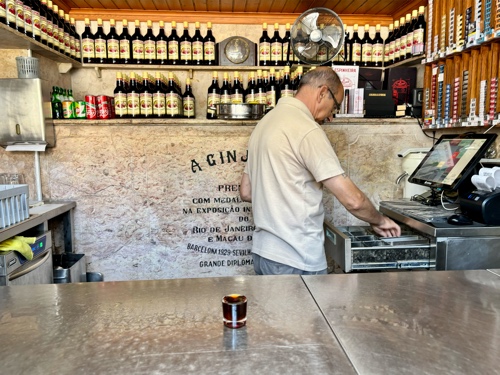
When I asked about where to get good paella in Lisbon, our guide was jokingly offended. He told me that they often see Spain as their cousin country. While Spain takes pride in paella, the Portuguese take pride in their seafood rice, “arroz de marisco.”
Stories behind the Historical Sites
Praça do Comércio (Commerce Square)
Lisbon's name itself means "a safe haven," a fitting description for a city with a rich maritime history.
In the heart of the city, the Praça do Comércio (Commerce Square) stands as a testament to its historical significance. The square features a statue of King Joseph I of Portugal from the 18th century, known for his complex legacy. He was a man of science who, despite his brilliance, was also seen as a coward because after the Lisbon earthquake, firestorm, and tsunami of November 1, 1755, in which between 30,000 and 40,000 people died. The earthquake caused Joseph to develop a severe case of claustrophobia, and he was never again comfortable living within a walled building.
The city's modern urban planning reflects its history of resilience, particularly against earthquakes. Buildings are designed to support each other, a technique developed after the devastating 1755 earthquake in Lisbon. This disaster also led to a unique social structure: the poor lived in the higher floors with smaller windows, while the rich occupied the lower floors for easier escape during earthquakes.
Largo de São Domingos Square and Igreja de São Domingos Church
In 1506, a tragic event known as the Lisbon Massacre or the 1506 Easter Slaughter took place near Rossio Square. Between 2,000 and 4,000 Jews who had been forced to convert to Christianity (known as "New Christians" or "Conversos") were killed in a violent pogrom that lasted for three days, a dark chapter in the city's history.
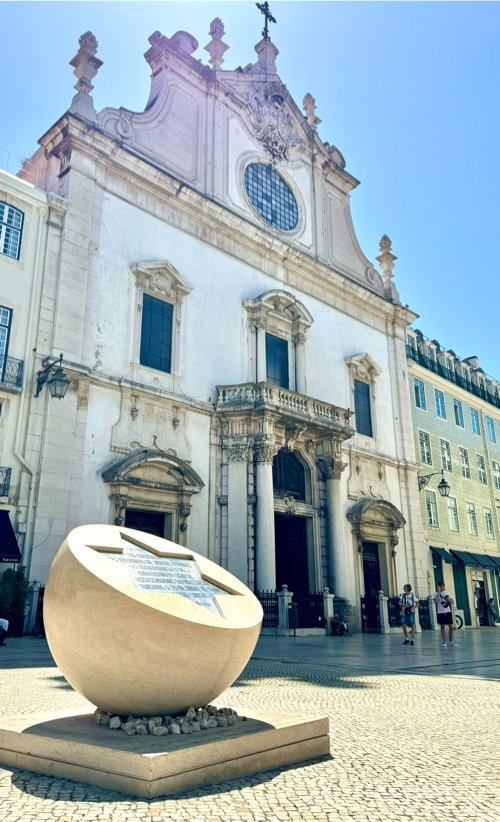
This massacre was partly fueled by tensions following the Spanish Inquisition of 1492, which had led to an influx of about 93,000 Sephardic Jews seeking refuge in Lisbon from Spain.
The situation was exacerbated by a severe drought and famine, along with an outbreak of the plague that had gripped Lisbon. These conditions created a climate of fear and desperation, and the Jewish community, as often happened in times of crisis, became a convenient scapegoat. Rumors spread that the Jews were responsible for the spread of the plague, and this incited the local population to violence. Ironically, Jewish communities often practiced ritual cleanliness and hygiene, which could have reduced the spread of disease, but these practices were misunderstood and fueled further suspicion and resentment.
To commemorate this tragic event, a memorial was erected on April 19, 2006, marking the 500th anniversary of the massacre. This Jewish Lisbon Memorial is located in Largo de São Domingos square, near the Igreja de São Domingos Church, close to Rossio Square.
The memorial consists of a round travertine stone with a bronze Star of David and bears an inscription remembering the victims of religious intolerance.
Stories like this make me think about religions even more differently than before. Human ignorance disguised in religious beliefs has caused a lot of harm to humanity, hasn’t it?
Also, once again, history does not treat Jews very well. They seem to be targets of persecution everywhere.
Largo do Carmo and The Carnation Revolution
Largo do Carmo is a poignant reminder of the Carnation Revolution to the Portuguese.
This non-violent revolution, which took place on April 25, 1974, ended 50 years of dictatorship, with the surrender of the dictatorship's prime minister, Marcelo Caetano, to the revolutionary forces. The army sided with the people. Today, April 25th is celebrated as Freedom Day, commemorating this pivotal moment in Portuguese history.
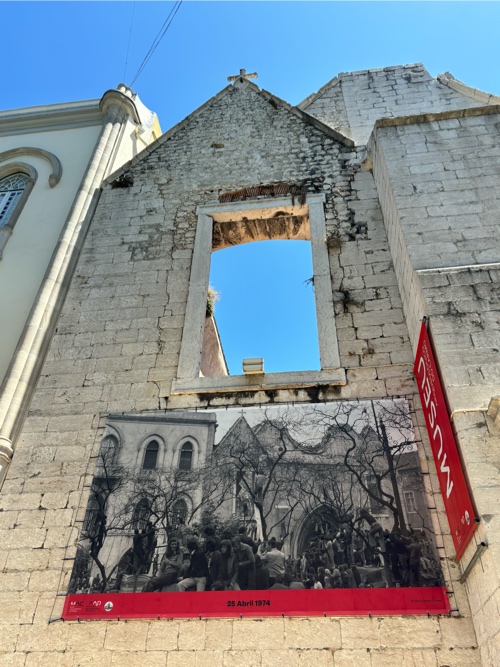 A photo on the building shows the event on April 25, 1974 at this location
A photo on the building shows the event on April 25, 1974 at this location
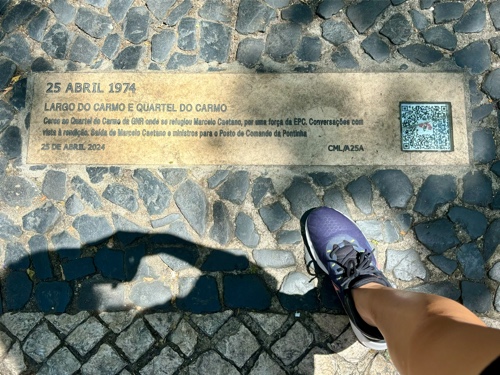
As our tour guide said, this was probably the only peaceful revolution in world history.
Language
I asked my tour guide why Spanish and Portuguese languages are so similar.
Portuguese, as a language, evolved from Latin and shares a common origin with Spanish. When Portugal declared independence in the 12th century, its language developed distinctively. The Portuguese pride themselves on this linguistic heritage, seeing it as an improvement over Spanish.
A Chat with A Local Chinese Restaurant
No matter which country we are in, we often look for Chinese food as well. We found a tiny noodle shop inside the city, with pretty authentic Chinese noodles. As we loved the food, we also chatted with the boss, a hardworking lady who immigrated from Wenzhou, China. She told us how hard she worked to support her daughter and how her entrepreneurial experience had an impact on her daughter. This brings another perspective about the city from the point of view of Chinese immigrants.
Conclusion
I have learned that stories make articles memorable in writing, and stories also make the places memorable. If you ever visit Lisbon, schedule a walking tour, and it will make your visit fun and unforgettable.
